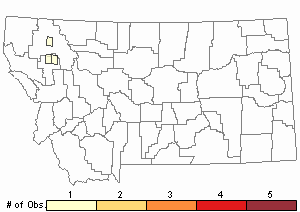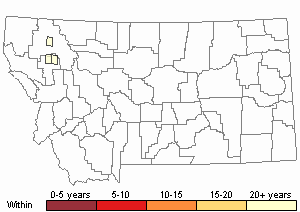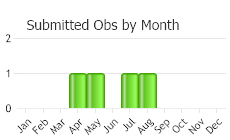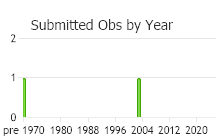View in other NatureServe Network Field Guides
NatureServe
Montana
Utah
Wyoming
Idaho
Wisconsin
British Columbia
South Carolina
Yukon
California
New York
Common Large-leaf Rhizomnium - Rhizomnium punctatum
General Description
Plants: Acrocarpous, growing in open tufts, light- to deep-green, frequently touched with red (Crum and Anderson et al. 1981). Stems turning russet to deep red with time, 1-5 cm in height; rhizoids brown (FNA 2014), with macronemata frequently woolly and matted at leaf axils and branch attachments (Crum and Anderson et al. 1981); micronemata lacking (FNA 2014).
Leaves: Remote except near the stem apices, upright to spreading, twisted, curved or bent when dry, spreading (Crum and Anderson et al. 1981) and typically flat or occasionally slightly wavy when damp, 2-7 mm in length, widest in the middle to widely obovate, ending in a curved leaf tip, occasionally obtuse or squared, forming a short apiculus or mucro; margins light green or occasionally somewhat red, flat, smooth; costa reaching the apex or nearly so, the upper part of the dorsal face smooth (FNA 2014).
Leaf Cells: Margins 2 to 4 cell-layers in thickness; marginal cells distinct, long to short, thin, in 3-4 series; medial laminal cells somewhat long to only slightly elongate, porose, with or without slightly thickened wall angles (FNA 2014); distal cells erratically 6-sided or appearing oblong with 6 sides, sometimes slightly elongated and in diagonal rows, porose, occasionally with wall angles thickened (Crum and Anderson et al. 1981); alar cells not distinct from adjacent cells (FNA 2014); costa in X-section appearing convex on both surfaces, without stereid bands (Flowers 1973).
Phenology
Fruit ripens in spring (FNA 2014).
Diagnostic Characteristics
A key characteristic for distinguishing Rhizomnium species is the presence or absence of micronemata on older stems. New growth often lacks micronemata, so checking and comparing mature stems, which may be covered with litter, is necessary (FNA 2014).
Range Comments
North American Range
Canada: BC to NL and NS; USA: AK, WA, ID, WY, CA, NM to AR, MS to GA, NC, WI, MI, OH and WV to NY, also NH and ME (FNA 2014). Known in Montana from Carbon, Cascade, Flathead, Gallatin, Judith Basin, Lake, Mineral, Missoula, and Sweet Grass Counties (Elliott and Pipp 2016).
Observations in Montana Natural Heritage Program Database
Number of Observations: 6
(Click on the following maps and charts to see full sized version)
Map Help and Descriptions
Relative Density

Recency


 (Observations spanning multiple months or years are excluded from time charts)
(Observations spanning multiple months or years are excluded from time charts)
Habitat
Wet soil, humus, rotten wood, and stones in seepy areas close to springs and swampy, high-nutrient, evergreen woods (Crum and Anderson et al. 1981), protected bluffs. From lowlands to medium elevations (FNA 2014).
Reproductive Characteristics
Dioicous. Seta solitary (FNA 2014) or seldom 2 (Crum and Anderson et al. 1981), 15-35 mm tall. Capsule 2-3.5 mm in length (FNA 2014), level to drooping, somewhat yellow or brown; stomata entirely sunken in the neck area (Crum and Anderson et al. 1981); exostome teeth 16, yellow with green tones (FNA 2014) or somewhat ochre; endostome with cilia in 2s or 3s (Crum and Anderson et al. 1981). Calyptra draped like a monk’s hood (FNA 2014).
Specialized vegetative reproduction from green macronemata (FNA 2014). When separated from the stem, the macronemata may produce protonemata (Crum and Anderson et al. 1981).
Stewardship Responsibility
References
- Literature Cited AboveLegend:
 View Online Publication
View Online Publication Crum, H.A. and L.E. Anderson. 1981. Mosses of Eastern North America. 2 volumes. Columbia University Press, New York. 1328 pp.
Crum, H.A. and L.E. Anderson. 1981. Mosses of Eastern North America. 2 volumes. Columbia University Press, New York. 1328 pp. Elliott, J.C. and A.K. Pipp. 2018. A Checklist of Montana Mosses (1880-2018). Updated 3 January, 2020. Montana Natural Heritage Program, Helena, Montana. 73 pp.
Elliott, J.C. and A.K. Pipp. 2018. A Checklist of Montana Mosses (1880-2018). Updated 3 January, 2020. Montana Natural Heritage Program, Helena, Montana. 73 pp. Flora of North America Editorial Committee, eds. 2014. Flora of North America North of Mexico. Volume 28. Bryophytes: Mosses, Part 2. Oxford University Press, Inc., NY. xxi + 702 pp.
Flora of North America Editorial Committee, eds. 2014. Flora of North America North of Mexico. Volume 28. Bryophytes: Mosses, Part 2. Oxford University Press, Inc., NY. xxi + 702 pp. Flowers, S. 1973. Mosses: Utah and the West. Brigham Young University, Provo, Utah. 567 p.
Flowers, S. 1973. Mosses: Utah and the West. Brigham Young University, Provo, Utah. 567 p.
- Additional ReferencesLegend:
 View Online Publication
View Online Publication
Do you know of a citation we're missing? Elliot, J. C. 1993. Second checklist of Montana mosses. Unpublished report. U.S. Forest Service, Region 1. Missoula, MT. 45 pp.
Elliot, J. C. 1993. Second checklist of Montana mosses. Unpublished report. U.S. Forest Service, Region 1. Missoula, MT. 45 pp. Malcolm, B., N. Malcolm, J. Shevock, and D. Norris. 2009. California Mosses. Nelson, New Zealand: Micro-Optics Press. 430 pp.
Malcolm, B., N. Malcolm, J. Shevock, and D. Norris. 2009. California Mosses. Nelson, New Zealand: Micro-Optics Press. 430 pp. Smith, A.J.E. 1980. The Moss Flora of Britain and Ireland. Cambridge University Press, Cambridge. 705 pp.
Smith, A.J.E. 1980. The Moss Flora of Britain and Ireland. Cambridge University Press, Cambridge. 705 pp.
- Web Search Engines for Articles on "Common Large-leaf Rhizomnium"





